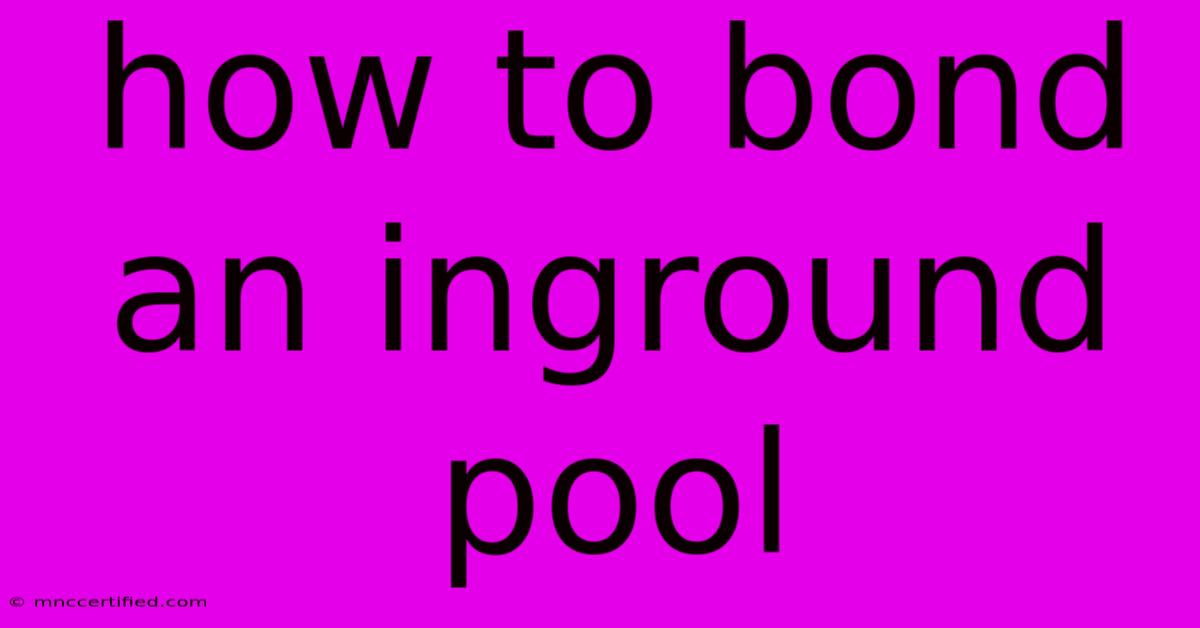How To Bond An Inground Pool

Table of Contents
How to Bond an Inground Pool: A Comprehensive Guide to Safety and Compliance
Bonding your inground pool is not just a recommendation; it's a crucial safety measure required by most building codes. Failing to properly bond your pool exposes you and your family to the risk of serious electrical shock. This comprehensive guide will walk you through the process, ensuring you understand the "why" and the "how" of effective pool bonding.
Why is Pool Bonding Essential?
The primary purpose of pool bonding is to equalize electrical potential throughout the pool's metallic components. This means connecting all metal parts – the pool shell, ladders, handrails, underwater lights, and any other metallic fixtures – to create a single, electrically safe environment.
Without bonding, a stray electrical current (e.g., from a faulty underwater light or a lightning strike) could create a dangerous voltage difference between different metal parts. Touching two such parts simultaneously could result in a potentially fatal electric shock. Bonding eliminates this risk by ensuring all metal surfaces are at the same electrical potential.
Key Benefits of Proper Pool Bonding:
- Enhanced Safety: The most critical benefit is the prevention of electrical shock.
- Code Compliance: Most jurisdictions mandate pool bonding to meet safety regulations.
- Peace of Mind: Knowing your pool is properly bonded provides significant reassurance.
- Protection of Equipment: It can also help protect your pool equipment from damage caused by electrical surges.
The Pool Bonding Process: A Step-by-Step Guide
The specific steps might vary slightly depending on your pool's construction and local codes, but the general process remains consistent. Always consult with a qualified electrician before beginning any electrical work. This isn't a DIY project for the inexperienced.
1. Gather Your Materials:
- Bonding Wire: Use appropriately sized copper bonding wire, typically 6 AWG or larger.
- Bonding Lugs: These are essential for creating secure connections.
- Ground Rod: A properly installed ground rod is crucial for grounding the system.
- Clamps: Heavy-duty clamps for secure connections to metal components.
- Voltmeter: To verify the bond's effectiveness after installation.
- Tools: Wire strippers, pliers, a shovel, and possibly a concrete drill (depending on your pool's construction).
2. Locate the Ground Rod:
Your ground rod should be driven into the earth a significant distance from the pool, ideally at least 6 feet deep. Ensure it's in contact with moist soil for optimal conductivity.
3. Connect the Bonding Wire:
Connect one end of your bonding wire to the ground rod using a bonding lug and appropriate clamp.
4. Connect to Metal Components:
Using clamps and bonding lugs, connect the bonding wire to all metallic components of the pool, including:
- Pool Shell: The main structural metal of the pool. Access points may vary; some pools require drilling.
- Ladders: Both top and bottom rails should be bonded.
- Handrails: All metal handrails and supports.
- Underwater Lights: The light housings should be directly bonded.
- Other Metallic Fixtures: Any other metallic parts, such as light poles or railings, should also be included.
5. Verify the Bond:
After completing all connections, use a voltmeter to verify that the electrical potential is equal across all bonded components. The reading should be near zero.
6. Documentation:
Keep records of the bonding process, including photos and details of the materials used. This is crucial for future inspections and insurance purposes.
Maintaining Your Pool Bond
Regularly inspect your pool's bonding system for any signs of corrosion, damage, or loose connections. Any issues should be addressed promptly by a qualified electrician.
Keyword Optimization & Off-Page SEO Strategies
This article utilizes several keywords throughout, including: pool bonding, inground pool bonding, electrical safety pool, pool bonding wire, how to bond a pool, pool bonding requirements, bonding pool equipment, pool bonding inspection. The use of headers, bold text, and a clear, logical structure enhances readability and SEO.
To further improve off-page SEO, consider:
- Backlinks: Promote this article on relevant forums and websites related to pools and home maintenance.
- Social Media Sharing: Share the article on social media platforms to increase visibility.
- Local SEO: If you offer pool bonding services, optimize your Google My Business profile.
By following these guidelines, you'll create a comprehensive and highly-optimized article about pool bonding, driving more organic traffic and establishing your online presence as a knowledgeable resource. Remember, safety is paramount when it comes to pool bonding. Always prioritize professional expertise.

Thank you for visiting our website wich cover about How To Bond An Inground Pool. We hope the information provided has been useful to you. Feel free to contact us if you have any questions or need further assistance. See you next time and dont miss to bookmark.
Featured Posts
-
College Football Today Crucial Games
Nov 30, 2024
-
Cowboy Bail Bonds Fort Worth
Nov 30, 2024
-
Homebase Sale Retail Giants Compete
Nov 30, 2024
-
What Is Secured Bond In Jail
Nov 30, 2024
-
Washington State Surety Bond
Nov 30, 2024